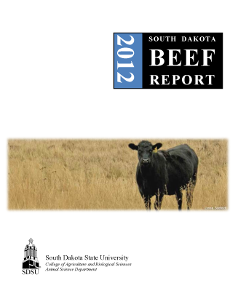Document Type
Report
Report Number
2012-4
Publication Date
2012
Summary
The objective of this experiment was to determine if early weaning (approximately 125 d) vs. normal weaning (approximately 250 d) and wintering replacement heifers in drylot versus rangeland affected heifer grazing distribution during the subsequent summer. Heifer calves from the 2009 and 2010 calf crop (n = 104 and 73, respectively) were allocated to the 2 weaning treatments and then stratified by age into the 2 winter development treatments. During the summer of yr 1 heifers were allocated to 2 pastures by winter treatment, and in yr 2, all 4 treatment combinations were allocated to separate pastures. A subset of heifers from each group was selected to wear global positioning system (GPS) collars (n=2 and 5 in yr 1 and 2, respectively). Readings were taken from the GPS every 15 min in yr 1 and every 65 s in yr 2. The GPS coordinates were then analyzed relative to ecological sites, water locations, fence locations, and temperature using Arc GIS (ESRI, Redlands, CA). Winter treatment affected (P<0.05) preference index (PI) for claypan and loamy sites in 2010, and distance from water in 2011. Day of sampling affected (P<0.05) claypan and loamy site PI in 2010 and thin claypan site PI in 2011. Day of sampling interacted with winter treatment (P<0.05) for distance from water in 2010, sand and thin claypan site PI in 2010 and thin claypan site PI in 2011, while day of sampling interacted with weaning treatment for distance from water in 2011. A winter by weaning treatment interaction affected (P<0.05) thin claypan site PI in 2011. Temperature had an effect on distance to fencelines in 2010 (P<0.001). There was a temperature interaction with wintered treatment effect on distance to water in 2011 (P<0.001). There was a three-way interaction (P<0.05) between weaning treatment, winter treatment and ambient temperate on the distance from water and between weaning treatment, winter treatment and day of sampling on claypan and sand site PI in 2011. In conclusion, winter development influenced patterns of range utilization. Day-of-sampling interactions indicated that range heifers did not adjust preferences and thus were already adapted to the range environment, whereas drylot heifers adjusted preferences over time suggesting they re-learned how to utilize the range environment.
Number of Pages
6
Format
application/pdf
Language
en
Publisher
South Dakota State University
Rights
Copyright © 2012 South Dakota State University.
Recommended Citation
Hojer, N.L.; Hubert, M.B.; Johnson, P.S.; and Price, M.H., "Effects of Weaning Age and Winter Development Environment
on Heifer Grazing Distribution" (2012). South Dakota Beef Report, 2012. 4.
https://openprairie.sdstate.edu/sd_beefreport_2012/4

